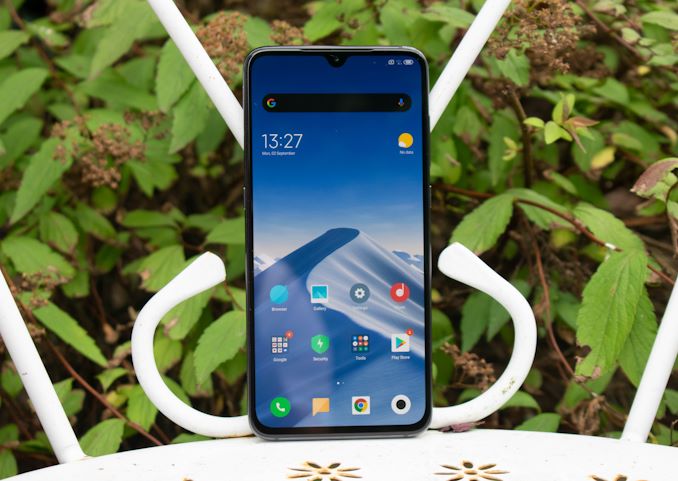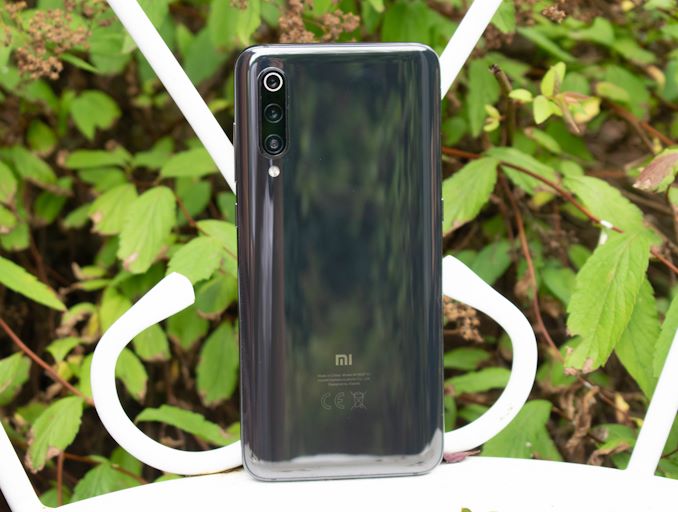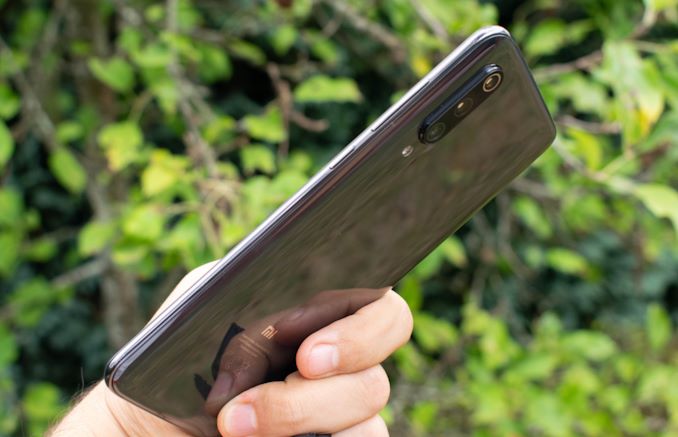The Xiaomi Mi9 Review: Flagship Performance At a Mid-Range Price
by Andrei Frumusanu on September 13, 2019 9:00 AM EST- Posted in
- Mobile
- Smartphones
- Xiaomi
- Snapdragon 855
- Xiaomi Mi9

We’re edging towards to latter half of 2019 and the next and last upcoming wave of device releases, however among the many device releases of the year one device we missed to review was the new Xiaomi Mi9. The phone was amongst the earliest releases of the year, being actually representing one of the first Snapdragon 855 devices announced back in February.
Xiaomi’s always been an interesting vendor that stood out alongside Huawei as one of the bigger Chinese vendors that have a larger presence in the west. Particularly last year and especially this year Xiaomi has made a lot of progress in terms of their push in European markets by officially releasing and offering their flagship devices in different market. The Mi9, as opposed to past iterations, thus no longer represents being a special case or import device, but rather a simple official Amazon purchase.
Today the Mi9 can be had for even less than its original 445€ launch price, being available for less than 400€, whilst still offering flagship performance, a triple camera setup, a great screen, all in a compact and attractive package. We’ll go over the device and exactly investigate how Xiaomi is able to offer such hardware at a low price, if there’s compromises and where they lie.
| Xiaomi Mi9 | ||||
| Xiaomi Mi9 | ||||
| SoC | Qualcomm Snapdragon 855 1x Kryo 485 (Cortex-A76) @ 2.84GHz 3x Kryo 485 (Cortex-A76) @ 2.42GHz 4x Kryo 485 (Cortex-A55) @ 1.80GHz Adreno 640 @ 585MHz |
|||
| DRAM | 6GB LPDDR4X | |||
| Display | 6.39" AMOLED 2340 x 1080 (19.5:9) |
|||
| Size | Height | 157.5 mm | ||
| Width | 74.67 mm | |||
| Depth | 7.61 mm | |||
| Weight | 173 grams | |||
| Battery Capacity | 3300mAh 18W charger included / 27W support |
|||
| Wireless Charging | Qi | |||
| Rear Cameras | ||||
| Main | 48MP IMX586 0.8µm pixel w/PDAF f/1.8 |
|||
| Telephoto | 12MP IMX481 1.0µm f/2.2 45° 2x zoom |
|||
| Wide | 16MP S5K3M5 1.0µm f/2.2 117° |
|||
| Extra | - | |||
| Front Camera | 20MP 0.9µm f/2.0 |
|||
| Storage | 64/128GB UFS 2.1 | |||
| I/O | USB-C no 3.5mm headphone jack |
|||
| Wireless (local) | 802.11ac Wave 2 Wi-Fi Bluetooth 5.0 LE + NFC |
|||
| IP Rating | none | |||
| Other Features | In-screen optical fingerprint sensor | |||
| Dual-SIM | 1x nanoSIM + microSD or 2x nanoSIM |
|||
| Launch / Street Price | 64GB: 449€ / ~400€ | |||
First off, hardware wise, the Mi9 is very much a flagship device in terms of its components. It’s powered by the Snapdragon 855 like many other flagships this year, representing an excellent base platform for the phone to build on.
Xiaomi bundles the SoC with 6GB of DRAM in the global models, and comes with either 64GB or 128GB of UFS 2.1 storage. Unlike many other vendors to price the higher storage tier with significant mark-up, the 128GB variant can currently be had for only 25€ more – with some listing only even being 3€ more than the 64GB variant, a great contrast to what we see from other high-end vendors out there today.
The Mi9’s display is powered by a 6.39” AMOLED screen with a resolution of 2340 x 1080. While personally I would have liked a 1440p screen, the majority of users will have absolutely no issue with the screen’s sharpness. The display is an edge-to-edge design with minimal bezels on all sides, and is characterised by having a teardrop notch at the top housing the front camera. This style of notch is common and is probably the least controversial of all implementations we’ve seen over the last 2 years.
The device’s back is a typical curved back glossy glass design with all its positives and negatives. The negatives being again that this is quite the fingerprint magnet, however Xiaomi’s ergonomics on the phone are very much fantastic and exemplary.
We find a vertical side located camera setup with triple cameras, including a regular wide-angle, zoom and ultra-wide-angle modules. The main sensor is again the common IMX586 48MP sensor that we’ve seen with essentially almost every vendor out there this year and is paired with an f/1.8 lens. The telephoto module has a 12MP IMX481 sensor with f/2.2 lens, and finally the wide-angle is an S5K3M5 16MP sensor with a f/2.2 lens with a 117° viewing angle. The noticeable feature that is lacking on all the modules here is any kind of OIS – most likely a cost-cutting measure. The lack of OIS might have also allowed Xiaomi to make the camera housing relatively more narrow and smaller than what one is accustomed to from other phones in recent years.
As mentioned, the device’s ergonomics are quite excellent and I have to say they’re among the best of device I’ve held this year. Although the phone of a larger form-factor with 6.39” screen and a device width of 74.67mm, the phone actually feels a lot smaller thanks to the very narrow and rounded frame. Even at the centre of the phone it’s only 7.61mm thick. The only compromise I see Xiaomi as having made is the relatively smaller 3300mAh battery, which competitively is a few hundred mAh below of other options in the market this year. The bonus here is that Xiaomi actually offers wireless charging on the Mi9, making it a rare feature amongst devices in this price range and definitely a bonus.
At the bottom of the phone we find the speaker grill on the right side, and symmetrical hole-cut-outs on the left side which house the bottom microphone. There’s no headphone jack here naturally – Xiaomi was amongst the first Android vendors to drop it a few years ago – still something I found unfortunate. The phone comes with a USB-C to 3.5mm adapter, which is at least more than what other vendors like OnePlus managed to offer this year. Another audio compromise on the Mi9 is that earpiece grill seems quite big and capable, it’s not being used for stereo playback, instead relying on the bottom firing speaker primarily.
On the left side of the phone we find the dual nanoSIM tray, and the assistant button below it. Xiaomi uses the Google assistant here and it works very well. The right side of the phone has your usual volume rocket button as well as power buttons. The phone also has an optical under-screen fingerprint sensor that in my experience worked quite flawlessly – it was maybe just a little slower than the implementations from OnePlus or Huawei, but it still seemed to remain faster than the ultrasonic implementation from Samsung.
Overall design wise I’m a big fan of the Mi9. It’s just such an ergonomic and no-nonsense device that I found it a rather fresh breath of air amongst other designs this year. There are some clear compromises for the phone – such as battery size, lack of IP rating or the single mono speaker, however these seem to be compromises one can live with given the price of the device.
This leads me to the question as to how Xiaomi is able to actually achieve such pricing – the company in its home market of China notably thrives on razor thing hardware margins by making profits off of their e-commerce services, but how does this play out in Europe? One way Xiaomi seems to making additional money is through ads integrated in the OS – although I love the MIUI interface and it’s an overall very clean experience, Xiaomi does show ads in instances such as when after installing application, referring to other apps such as in my experience Booking.com. This really didn’t bother me too much as it’s only ever displayed it after installing applications, but it’s something that needs mention.
















96 Comments
View All Comments
Redmyth79 - Friday, September 13, 2019 - link
I'm going to call Bullshit on your scores because I have the Note 9, S9+ and the Xiaomi Mi 9 EU Global ROM and my scores including FPS and a lot of things you have posted here do not come close to the performance I'm getting.My Mi 9 best every phone you have up there in most every one of those test.
It lost to the ROG 2 and Black Shark 2pro in a couple area's but very limited. Matter fact though, what makes anybody with a ounce of common sense know that this testing is completely fabricated bullshit is the fact that the S10+ is up top or near the top in a lot of spots because the S10+ has the worst testing of just about any 855 chipped phone. Furthermore you have the S9+ rated higher in certain test that I personally ran and there are official results from those very testing sites saying your results are off by more then a 1000 points in some areas with the S9+ even.
I don't get the sham going on here but it just ruined any credibility this site ever had!
NXTwoThou - Friday, September 13, 2019 - link
Are you still using the stock rom? I'm pretty sure AnandTech didn't bother getting the latest greatest(and probably hasn't had it long enough to get unlocked or xiaomi.eu). I know my phone had a huge performance difference after a few updates.Andrei Frumusanu - Friday, September 13, 2019 - link
It's running the latest OTA on a commercial EU unit, build date July 9th. The phone's been out long enough that didn't go finishing for nonpublic firmwares.Redmyth79 - Friday, September 13, 2019 - link
What update? What's the number 10. What?I currently have 10.2.30.0 and have not complaints except for the fact that around the 10.2.26 update I lost the ability to control saturation, sharpness and contrast.
Andrei Frumusanu - Saturday, September 14, 2019 - link
10.28Redmyth79 - Friday, September 13, 2019 - link
So you understand what I'm calling bullshit on is the performance charts with GPU and CPU test with the many test. The one thing the Xiaomi Mi 9 truly excels at is CPU, GPU and overall speed and gaming experience always running at the top of any flagship out. The only one I've seen close is the OnePlus 7 pro.As far as your end review, I saw your camera info, you are wrong in a few areas here as well.
The Xiaomi Mi 9 does have a advanced EIS that is not like others but is actually a advanced form of OIS with a extra sensor that watches the movement of the OIS to give it more accurate and faster info to make proper adjustments to make the Mi 9 one of the most stable of all current smartphones in 4k@30 video.
Any YouTube reviews and also dxomark will show this without question up amongst all the rest.
If I can post the link to the Mi 9's EIS I will do it here for those to read up on it.
Last, I don't have a issue with low light pics and most reviews show the same bit it's not of the level of the Note 10+, P30 pro or Pixel without Gcam for night shots.
gizchina.com/2019/02/17/mi-9-closed-loop-motor-explained/
Of course you have to put in the http/www part on that link.
porcupineLTD - Friday, September 13, 2019 - link
A new fanboy arrives.Redmyth79 - Friday, September 13, 2019 - link
Fanboy of what I've always been a Galaxy fanboy sense I've owned all from S4-S9+ but the Mi 9 is truly a game changer to meNXTwoThou - Friday, September 13, 2019 - link
As a fyi, I've taken some rather craptackular shots with my Mi9. I've also taken some astoundingly good ones. Previously I was Lumia 950 and 920 before that. I'd been used to relatively good cameras on my phones. Lack of OIS is a big deal and the EIS doesn't make up for it. I have some health issues that cause trembles, my older phones it made zero difference, with the Mi9 it's very apparent when I'm having a bad day. Even when I'm not having a bad day I can still get bad shots where the same environment had previously been no issue for my previous phone.The Mi9 is an insanely good value. I love my phone. I just recognize the issues presented in the article are valid.
Jon Tseng - Sunday, September 15, 2019 - link
If you have good benchmarks and data post them rather than ranting.Talk is cheap if you're too afraid to back it up.
Anandtech has years of best in class work around mobile performance analysis. Forgive me if I give them the benefit of the doubt.